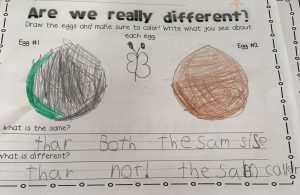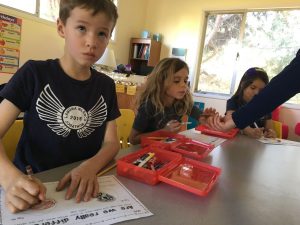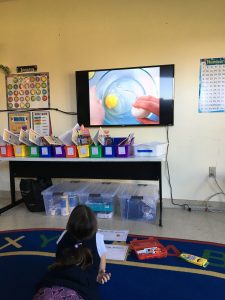
Yesterday during social studies, I told the students that we would become scientists to do an “egg-speriment.” We discussed how a scientist’s job involves carefully observing things and recording his or her observations. I gave each student a recording sheet, told them I would show them two eggs, and they should carefully record their observations about each egg. We inspected egg #1 and noted that it was white, kind of bumpy, round, cold, and had some yellow spots on it. Then we inspected egg #2 and noted that it was tan, round, cold, mostly smooth, and had some brown spots on it. We noted that the eggs were a similar size, shape, and temperature, but that they were different colors and slightly different textures.




Then, I asked the students to make predictions about the insides of the eggs. Some student predicted that they might contain baby chicks, feathers, yolks, or even confetti! Some students thought the insides of both eggs would be different, and some thought they would be the same. I gave each student another recording sheet and asked them to carefully record their observations as we cracked both eggs open.

When I cracked egg #2, the students saw that the insides of both eggs were…about the same! Both contained a white and a yolk. There were some small differences, including the size and color of the yolk, but we agreed they were basically the same. Nobody could agree for sure on which yolk came from which egg, once I swirled them around a bit in the bowl.


“But Mrs. Vanetti, this is like science! Our schedule says it’s time for social studies!”
Yes! This opened up a discussion about how the eggs can represent people: we come in all different colors, shapes, and sizes, but on the inside, we are very similar! We have the same needs and similar wants. Everyone hurts when they skin their knee. Many people like chocolate ice cream, but some don’t. Some people like roller coasters, and others feel sick to their stomachs just talking about them! (We ended the roller coaster talk quickly when someone mentioned this!)
I told the students that we would be learning about the Civil Rights Movement in the United States. Many students were familiar with the basics, and we shared what we knew about Dr. Martin Luther King, Jr.’s work and how the laws went through changes during that time to become more inclusive to all people. We discussed how silly it is to treat people differently because of the way they look — “Nobody can choose the color of their skin or eyes or hair!” The students were surprised to learn that Dr. Martin Luther King, Jr. didn’t fix all the problems and that, once the laws changed, everything wasn’t automatically equitable, but that they were important first steps in the right direction.

We finished the lesson by reading the book, “Freedom Summer.” Here’s the summary from Amazon: Joe and John Henry are a lot alike. They both like shooting marbles, they both want to be firemen, and they both love to swim. But there’s one important way they’re different: Joe is white and John Henry is black, and in the South in 1964, that means John Henry isn’t allowed to do everything his best friend is. Then a law is passed that forbids segregation and opens the town pool to everyone. Joe and John Henry are so excited they race each other there…only to discover that it takes more than a new law to change people’s hearts.
I told the students that next week, we would learn about how an actual first grader was part of the Civil Rights Movement! They were very excited to learn about how a person their age could have a big impact on our country.
So glad you are carrying on under such difficult circumstances. I taught at an almost all black school and met both Ruby Bridges and Rosa Parks! Humbling experiences to say the least. I hope that no one in your family was affected by the devastating fires and floods!